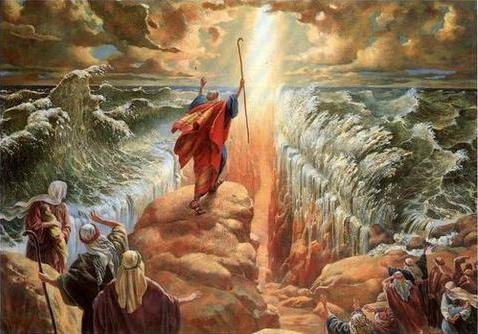
Online Texts for Craig White's Literature Courses
|
|
selections from the Exodus story in the Old Testament of the Bible click on links below for readings
|
|
-
Exodus,
chapters 1-15; chapter 16, verses 1-4; chapter 20; chapter 31, verse 12 through
chapter 32 complete.
-
Leviticus,
chapter 18, verses 1-5 and Numbers, chapter 14, verses 1-9; chapter 33
-
Deuteronomy,
chapter 7, verses 1-6; chapter 11, verses 10-17.26-28; chapter 12, verses 2-3;
chapter 34.1-6
- Joshua, chapter 24 & Judges, chapter 2, verses 1-15

Instructor's introduction:
The Exodus [Greek for “coming out of Egypt”] is the story of the Jewish people’s escape from slavery in Egypt to “the promised land” of Canaan. This story begins in Exodus, the second book of the Torah or the Old Testament of the Bible, but it continues in later books.
This reading's purpose for American Immigrant Literature is to establish a textual-historical model for Objective 4:
Objective 4. To identify the United States' “dominant culture” to which immigrants assimilate.
Examples of national migration and dominant culture for objective 4
- Our deep historical model for
“national migration” is the ancient Jews who migrated from Egypt to
Canaan in the Bible’s Exodus story.
- The standard immigrant story
concerns families and individuals who strive to adapt to the prevailing
culture. In contrast, the Jews moved to the Promised Land as a group
and resisted assimilation and intermarriage with the Canaanites.
American Jews have followed this pattern until recent generations, when
intermarriage has increased.
- Our American historical model for
“national migration” is the “Great Migration” of English Pilgrims and
Puritans to early North America, where they imitated the Jews in Canaan by
refusing to intermarry or assimilate with the American Indians. This English
culture became one basis for the USA’s dominant culture to which American
immigrants assimilate.
- A relatively recent internal
example of “national migration” might be that of the Mormons in the 1800s
from the Midwest to Utah, where they became the dominant culture.
- Some elements of national migration and correspondence to Exodus may also appear in the “great migration” of African Americans from the Old South to the urban North during slavery times, in the early twentieth century, and in the Civil Rights movement of the 1960s.

Instructor's notes regarding use of King James Version of Bible:
- Students may read any translation.
The King James Version (KJV) is our
default translation because of its literary quality and influence. Also
it's out of copyright.
- Some spelling updates are made to simplify reading.
- Highlights or bolds are by the professor and made for association with objectives, lectures, and discussions.
No distortion of scripture is intended. Plenty of unmarked translations are
available elsewhere.
- Bracketed comments or information are minimal but intended to simplify reading or help with objectives.
-
Some of the extended events from the Book of Exodus connect only tangentially to this larger purpose, but Moses’s interactions with Pharaoh or the Ten Commandments are so famous as to defy cuts or condensations.
-
As for the cuts made, they are mostly for the sake of easing reading—no intention of disrespecting scripture. The passages cut seemed non-essential to our purposes. Consolation: if you miss the parts that were cut, they are easily available from other sources.

-
Not a critical or scholarly text but a reading text for a seminar
-
Gratefully copied and adapted from BibleGateway.com
-
Changes may include paragraph divisions, highlights, spelling updates, bracketed annotations, & elisions (marked by ellipses . . . )

